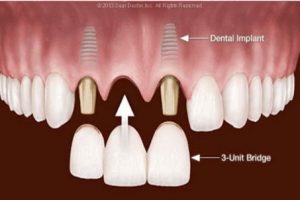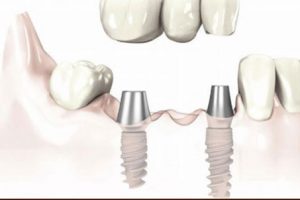Having dental implants replacing your lost multiple teeth will give you new, unparalleled stability that allows you to eat what you want. It will also preserve your jawbone and facial appearance, and this can be accomplished by matching dental implant bridges and using less implant to replace multiple teeth.



When Is This Used?
An implant-supported bridge is used when more than one tooth is missing. It also may be used when your dentist is concerned that you might put too much pressure on individual implants that are not connected to each other. For example, clenching or grinding your teeth can put a lot of pressure on individual implants. This can increase the chances that they will loosen from the bone and fail. An implant-supported bridge reduces the pressure on the individual implants in the bone, and spreads it across the entire bridge.
If the implants will be placed next to natural teeth, the natural teeth and surrounding gums must be in good health. If you don’t have enough bone to place and support the dental implants, the supporting bone can be built up using bone augmentation or grafting before the actual implant procedure begins.
How Does It Work?
In some cases, your dentist may not want to put an implant in a certain place in your mouth. There may not be enough jawbone to support an implant, or the location may be too close to a nerve or sinus cavity (located above your upper teeth). In that case, your dentist can avoid the area by placing implants on both sides of the space. An implant-supported bridge will be placed on top. An implant-supported bridge also can be made similar to a traditional bridge, with a crown suspended between two implant-supported crowns.
An implant-supported bridge consists of:
The implant is made of titanium and surgically placed in the jawbone. You may have one implant for each missing tooth. In other cases, your dentist may skip one or more spaces because there’s not enough jawbone, or because the space is too close to a nerve or your sinus cavity.
The abutment, a cylinder made of titanium, gold or porcelain, is screwed onto the implant. In the past, some abutments were attached to the implant using cement. Today all abutments are secured with screws. Abutments can be pre-fabricated or custom-made by the dental lab.
The restoration-Dental Implant Bridge (the part that looks like teeth) is a series of crowns connected to form a bridge. They are made of porcelain attached and fused to a substructure of metal
